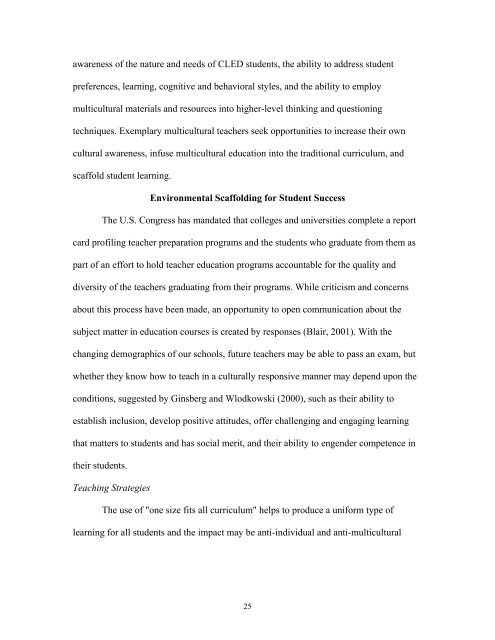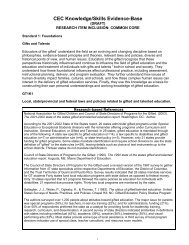Chapter One An Introduction to the Topic of Cultural Diversity - NAGC
Chapter One An Introduction to the Topic of Cultural Diversity - NAGC
Chapter One An Introduction to the Topic of Cultural Diversity - NAGC
Create successful ePaper yourself
Turn your PDF publications into a flip-book with our unique Google optimized e-Paper software.
awareness <strong>of</strong> <strong>the</strong> nature and needs <strong>of</strong> CLED students, <strong>the</strong> ability <strong>to</strong> address student<br />
preferences, learning, cognitive and behavioral styles, and <strong>the</strong> ability <strong>to</strong> employ<br />
multicultural materials and resources in<strong>to</strong> higher-level thinking and questioning<br />
techniques. Exemplary multicultural teachers seek opportunities <strong>to</strong> increase <strong>the</strong>ir own<br />
cultural awareness, infuse multicultural education in<strong>to</strong> <strong>the</strong> traditional curriculum, and<br />
scaffold student learning.<br />
Environmental Scaffolding for Student Success<br />
The U.S. Congress has mandated that colleges and universities complete a report<br />
card pr<strong>of</strong>iling teacher preparation programs and <strong>the</strong> students who graduate from <strong>the</strong>m as<br />
part <strong>of</strong> an effort <strong>to</strong> hold teacher education programs accountable for <strong>the</strong> quality and<br />
diversity <strong>of</strong> <strong>the</strong> teachers graduating from <strong>the</strong>ir programs. While criticism and concerns<br />
about this process have been made, an opportunity <strong>to</strong> open communication about <strong>the</strong><br />
subject matter in education courses is created by responses (Blair, 2001). With <strong>the</strong><br />
changing demographics <strong>of</strong> our schools, future teachers may be able <strong>to</strong> pass an exam, but<br />
whe<strong>the</strong>r <strong>the</strong>y know how <strong>to</strong> teach in a culturally responsive manner may depend upon <strong>the</strong><br />
conditions, suggested by Ginsberg and Wlodkowski (2000), such as <strong>the</strong>ir ability <strong>to</strong><br />
establish inclusion, develop positive attitudes, <strong>of</strong>fer challenging and engaging learning<br />
that matters <strong>to</strong> students and has social merit, and <strong>the</strong>ir ability <strong>to</strong> engender competence in<br />
<strong>the</strong>ir students.<br />
Teaching Strategies<br />
The use <strong>of</strong> "one size fits all curriculum" helps <strong>to</strong> produce a uniform type <strong>of</strong><br />
learning for all students and <strong>the</strong> impact may be anti-individual and anti-multicultural<br />
25

















